
The transformation of Vietnam's economic structure has led to a significant shift in the labor market. With economic liberalization and diversification, the share of employment in Agriculture quickly decline, contrast of industry and services.

This report is comprehensive about employment in Vietnam from 2008 up to the present time. The report includes four sections, the employment overview, the Labor force, Salary, and Unemployment in Vietnam. Besides, due to the Covid-19 pandemic that explored and affected all countries worldwide, Vietnam was seriously affected in all socio-economic fields, especially labor and employment. So this report also mentions some points of employment in the context before and during the Covid-19 pandemic in Vietnam.

According to the Statista Employment in Vietnam report, the labor force in 2008 reached 46.46 million people. After ten years, the total labor force in Vietnam was 54.25 million people, an increase of 7.79 million people with a growth rate of nearly 17% in 2018. In 2019, the total number of employed people in Vietnam was 55.77 million people, up to 1.25 million people compared to the same period last year, with a growth rate of 2% compared to the previous years.
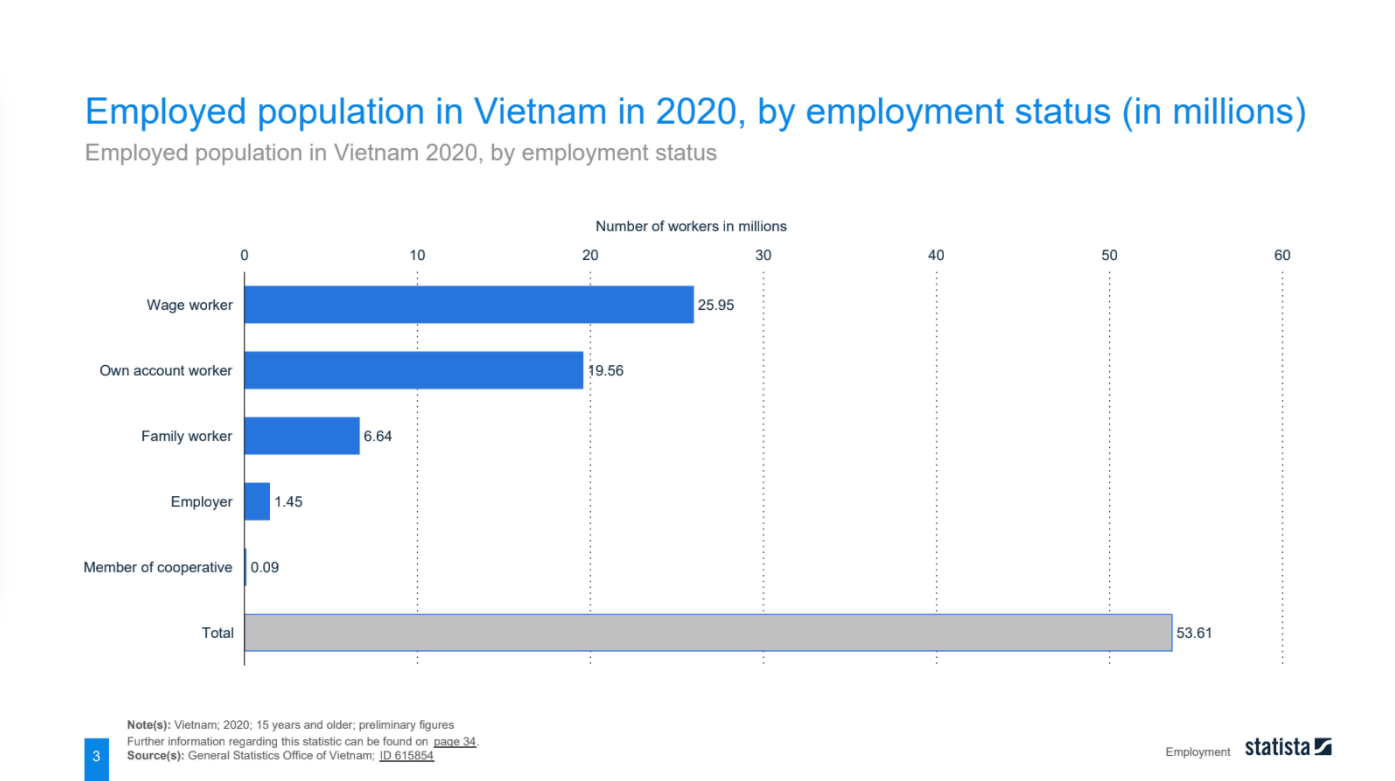
In the total of 53.61 million employed people in 2020, Vietnam has more than 25 million wage workers, more than 19 million self-employed, more than 6.6 million family workers, 1.45 million employers, and just 0.09 million employed members of the cooperative. The proportion of self-employed workers accounts for a large proportion close to the wage workers in Vietnam.
In 2010, the employment in Vietnam by economic sector included three sectors. The employment by the Agriculture sector accounted for 48.71% of the total employment. The employment by industry sector accounted for 21.68%. The employment by the Service sector accounted for 29.61% of the total employment.
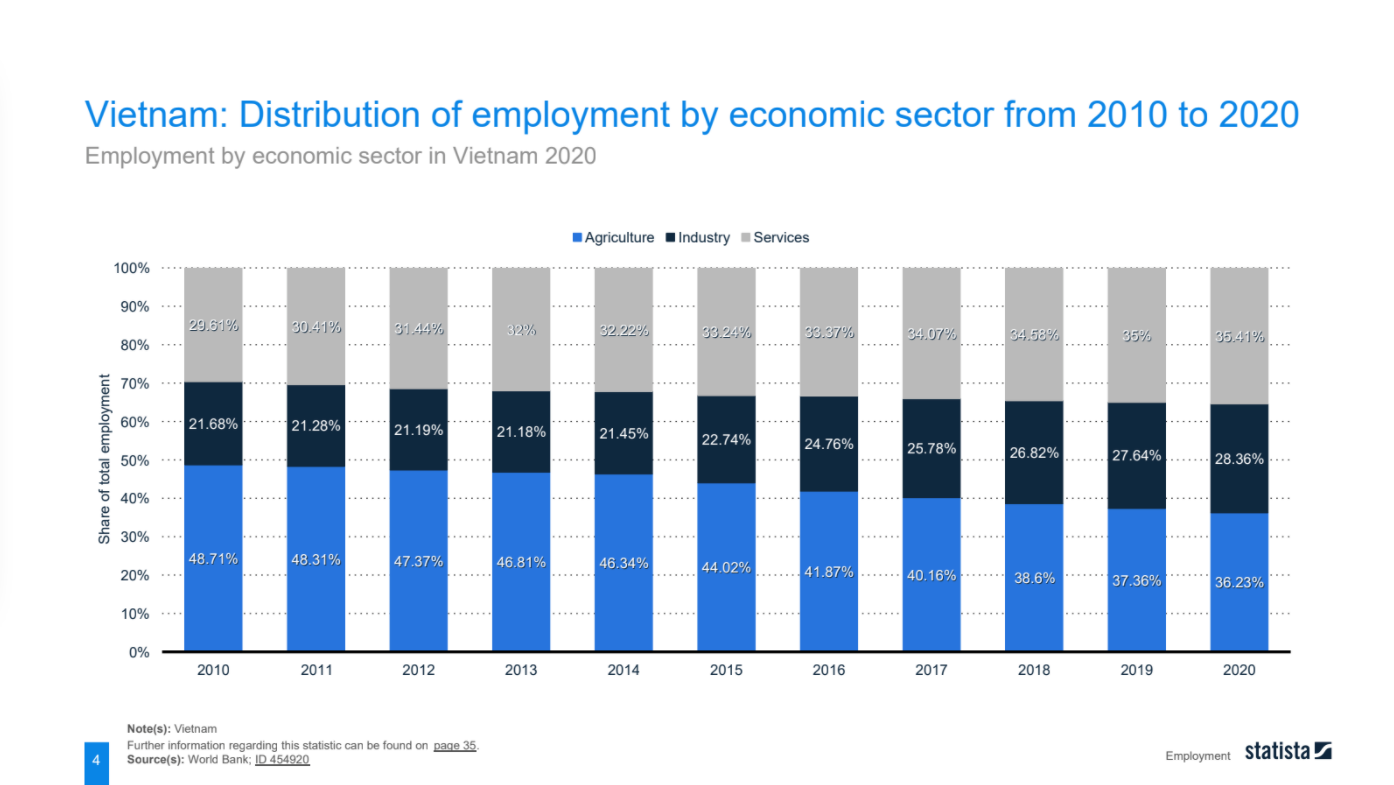
According to the report, the total labor force has moved significantly in 10 years. The labor force has increased in the Service and Industry sectors and decreased in the Agriculture sector. Specifically, in 2020, the labor force in the Agriculture industry accounted for 36.23% of the national labor rate, down 12.48% compared to 2010 and down 1.13% compared to the previous year. In 2020, the workers in the Service industry accounted for 35.41% of the total labor force increase of 5.8% compared to 2010 and 0.41% over the previous year. 28.36% of the national labor force works in the Industry sector, an increase of more than 7% compared to 10 years ago and 1% compared to the previous year.
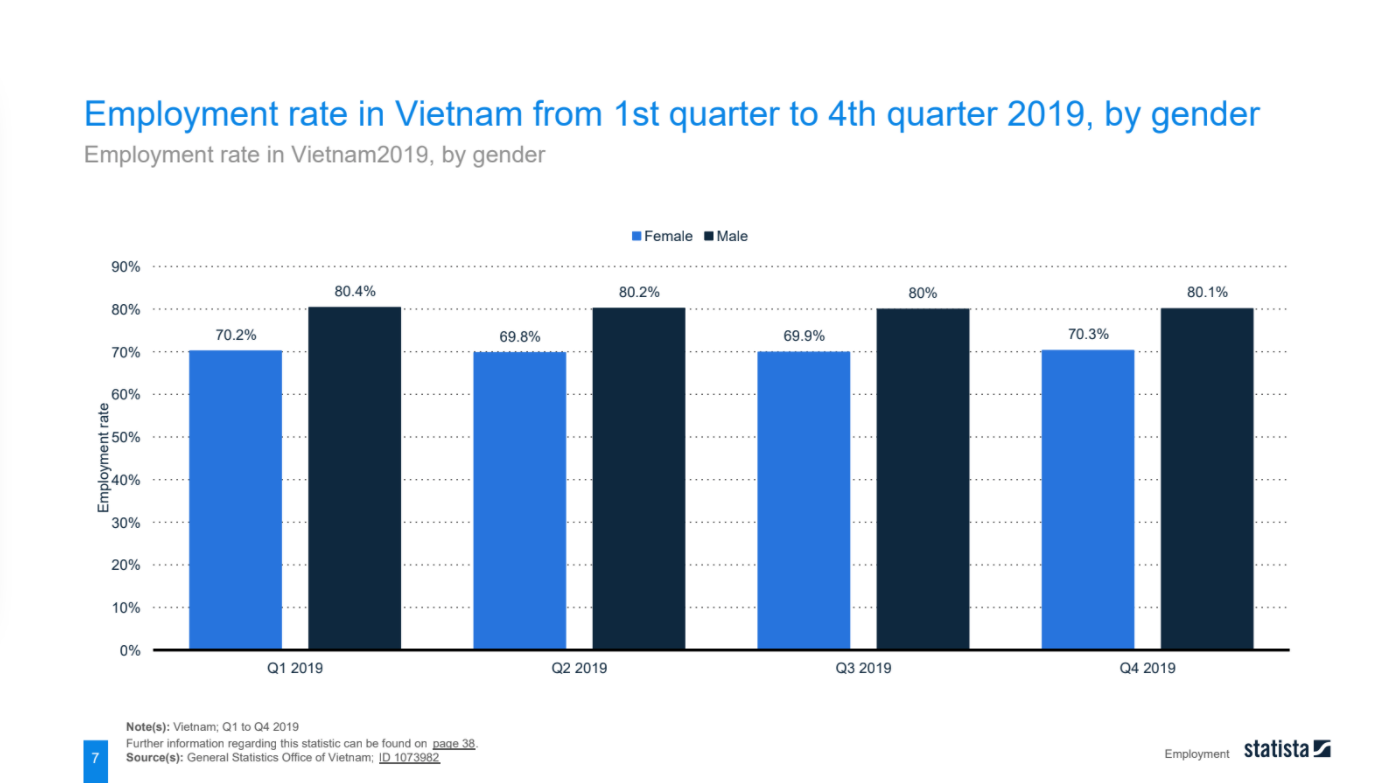
The female workers account for 70.2% of the employment of the whole country, and male workers account for more than 80% of the employment under working age. And this hardly changes from 1st quarter to 4th quarter 2019.
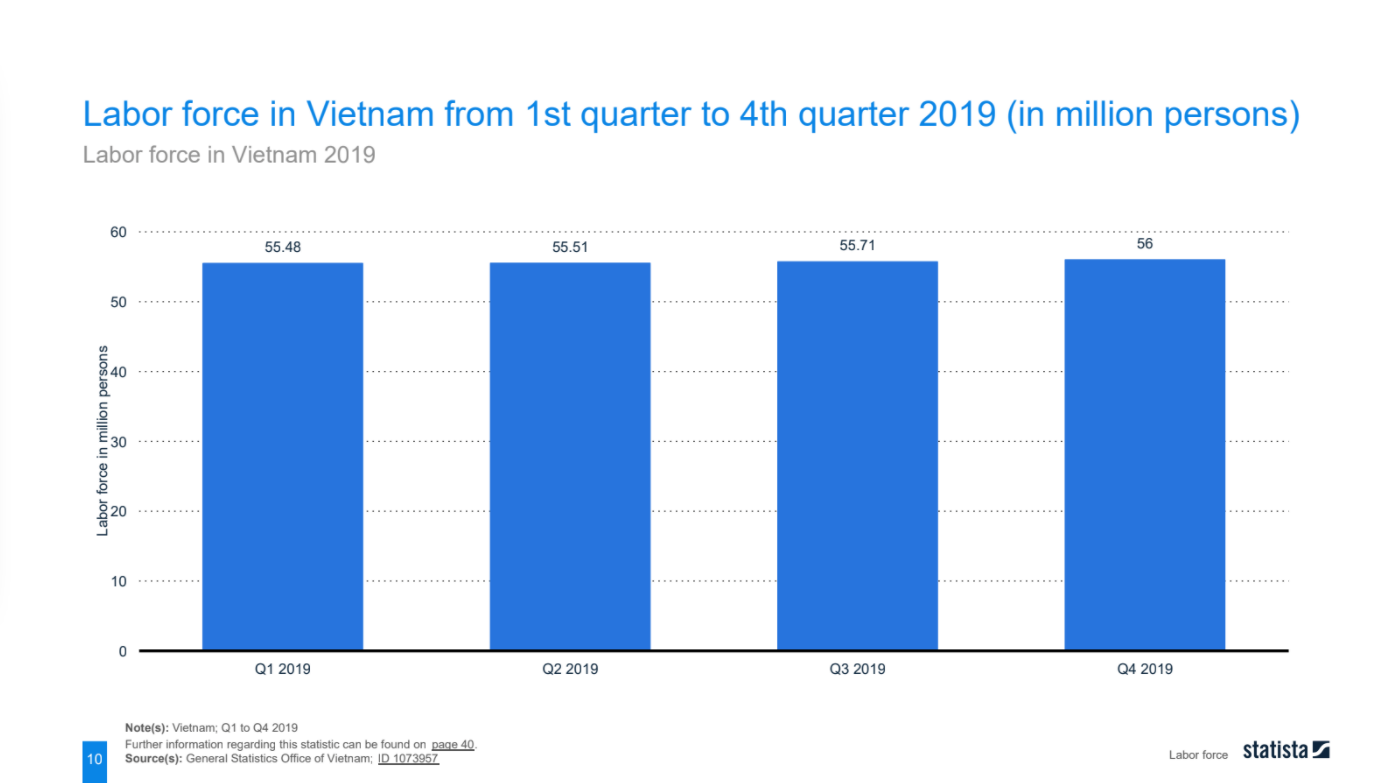
The labor force in Vietnam tends to increase steadily from the first quarter to the fourth quarter of 2019. In the first quarter, the Vietnamese labor force reached 55.48 million people; in the fourth quarter of 2019, it reached 56 million people, an increase of 4.52 million people compared to the first quarter. In the 4th quarter of 2019, Vietnam had 29.46 million male workers and 26.54 million female workers.
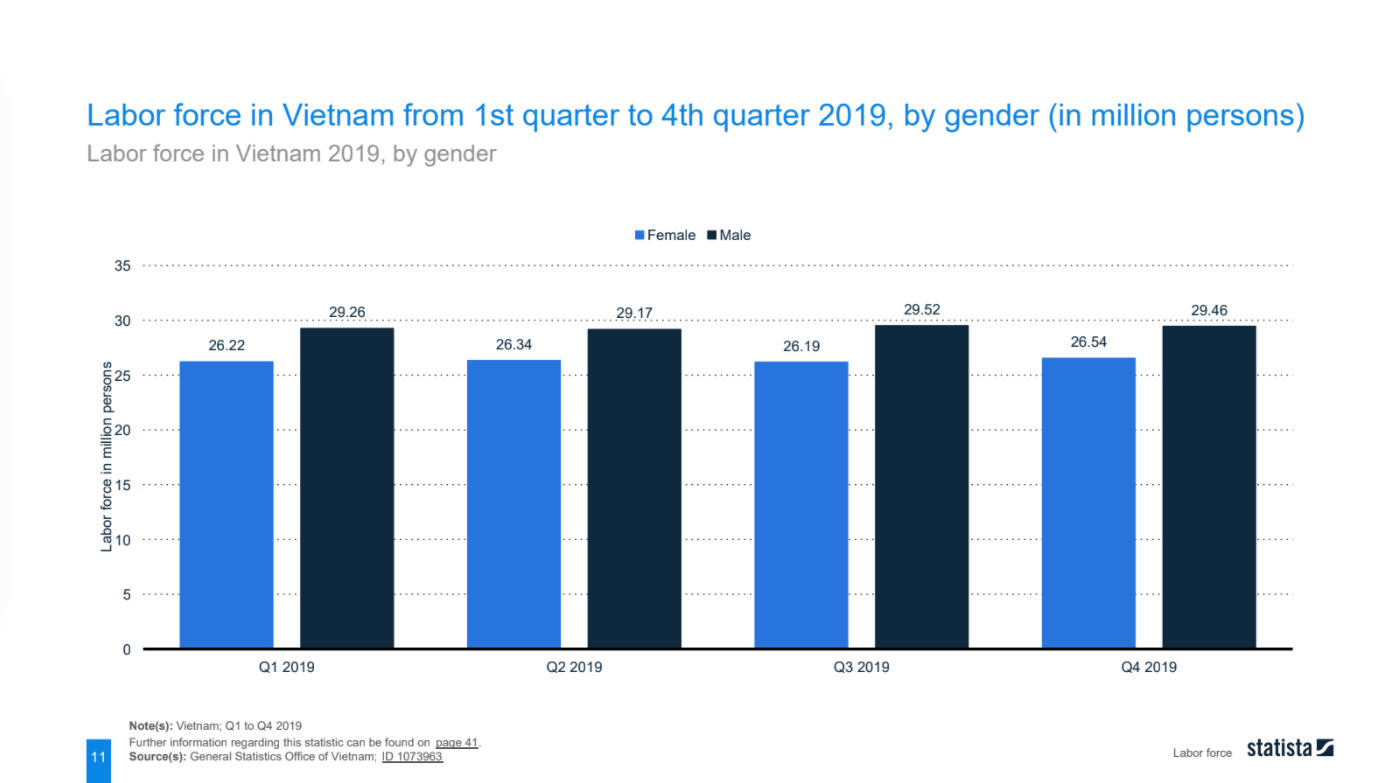
In the 4th quarter of 2019, Vietnam's labor force was 56 million people. The workers in rural areas increased by 0.92% (compared to the 1st quarter 2019); the labor force in rural areas was higher than the labor force in urban areas from time to time.

The Labor force participation rate in Vietnam from 1s quarter to 4th quarter 2019 data show that the labor force participation rate in the 4th quarter of 2019 is estimated at 76.6%, down 0.1% compared to the labor force participation rate of Vietnam in the first quarter (76.7%).
The male labor force participation rate in the 4th quarter is 81.8% higher than the female labor force participation rate (71.7%). The female labor force increased compared to the previous quarter (0.3%), while the male labor force increased slightly compared to the previous quarter (0.2%). The labor force participation rate in rural areas is higher than in urban areas. It tends to increase from month to month. In the 4th quarter of 2019, the labor force participation rate in rural areas accounted for 80.7%, an increase of 0.6% compared to the previous quarter and higher than the Labor force participation rate in urban areas (11.3%).
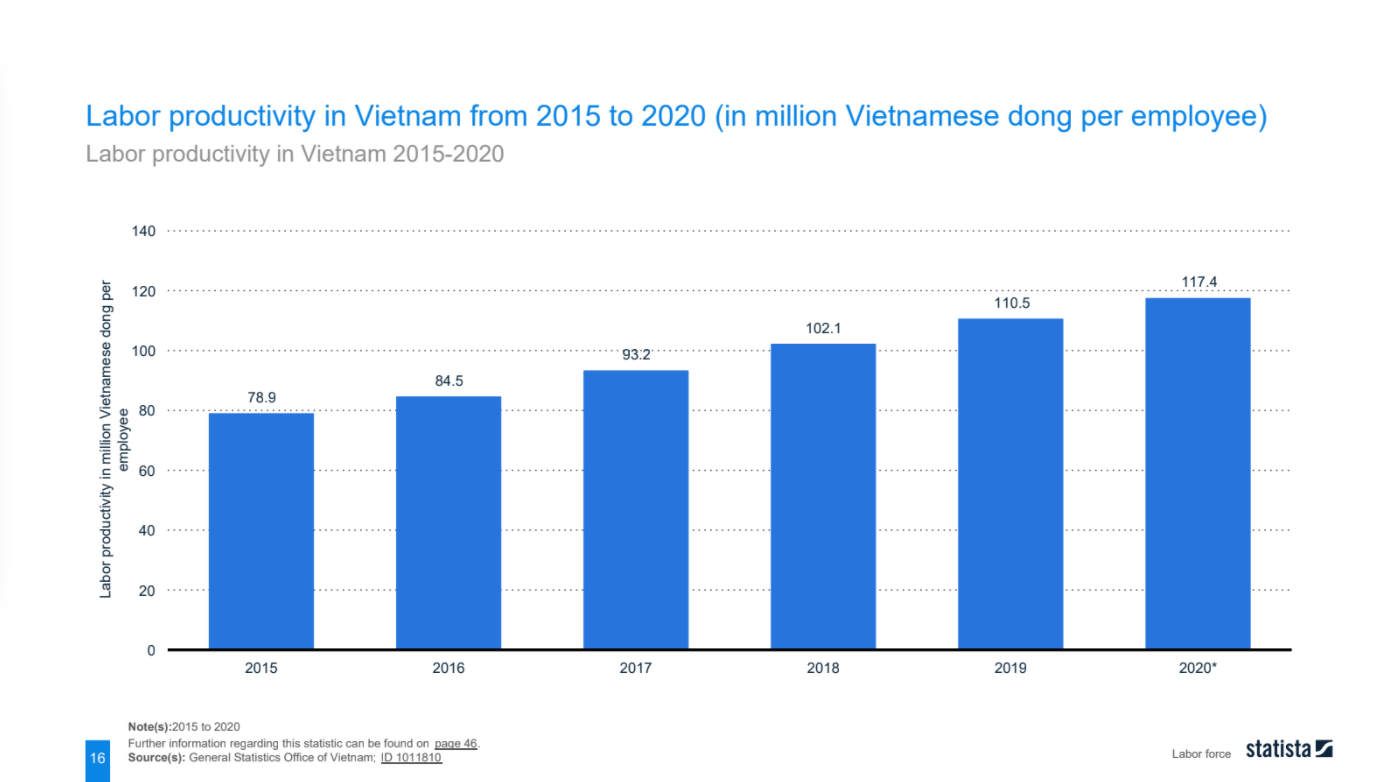
According to the report and data from the General Statistics Office of Vietnam from 2015 to 2020, Vietnam's labor productivity increased by only 6.9% in 2020 compared to the previous year (in 2019, it was 8.4%) and at the lowest level in the past decade five years ago. Specifically, the average labor productivity reached 117.4 million VND. Labor productivity per hour worked in Vietnam increased and reached $6US in 2018, an increase of $1US compared to the previous month and is at the highest level in the past 17 years.
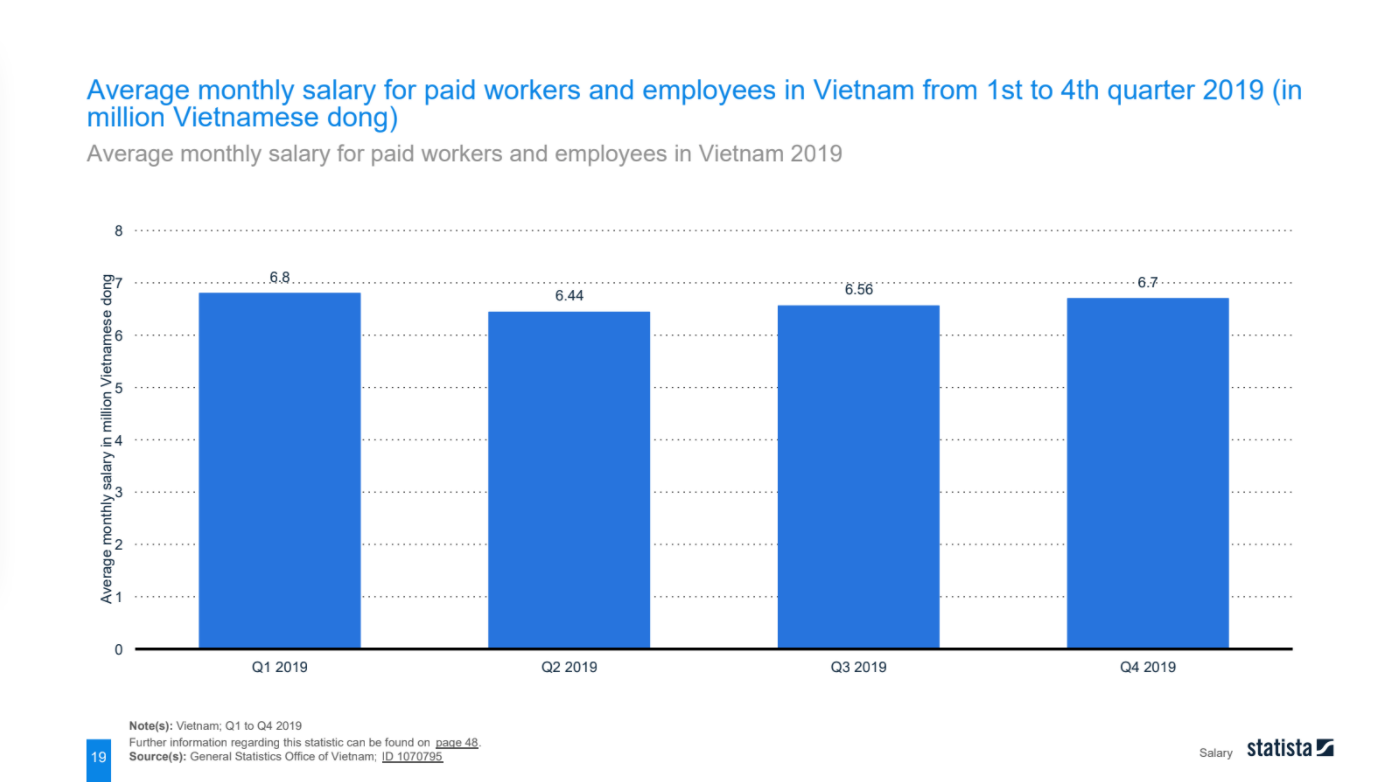
The average salary for paid workers and employees in Vietnam from 1st to 4th quarter 2019 was 6.7 million VND/month in the 4th quarter of 2019, an increase of 0.14 million VND, down about 0.1 million Dong compared to the 1st quarter in 2019 (6.8 million VND/month).
From 1st quarter to 4th quarter 2019, the male workers had an average monthly salary higher than the female workers'. The average monthly salary for Male workers in the 4th quarter of 2019 was at 7.08 million VND, an increase of 0.02% compared to the previous quarter (6.94 million VND/month), but decreased 0.05 million dongs compared to the 1st quarter in 2019.
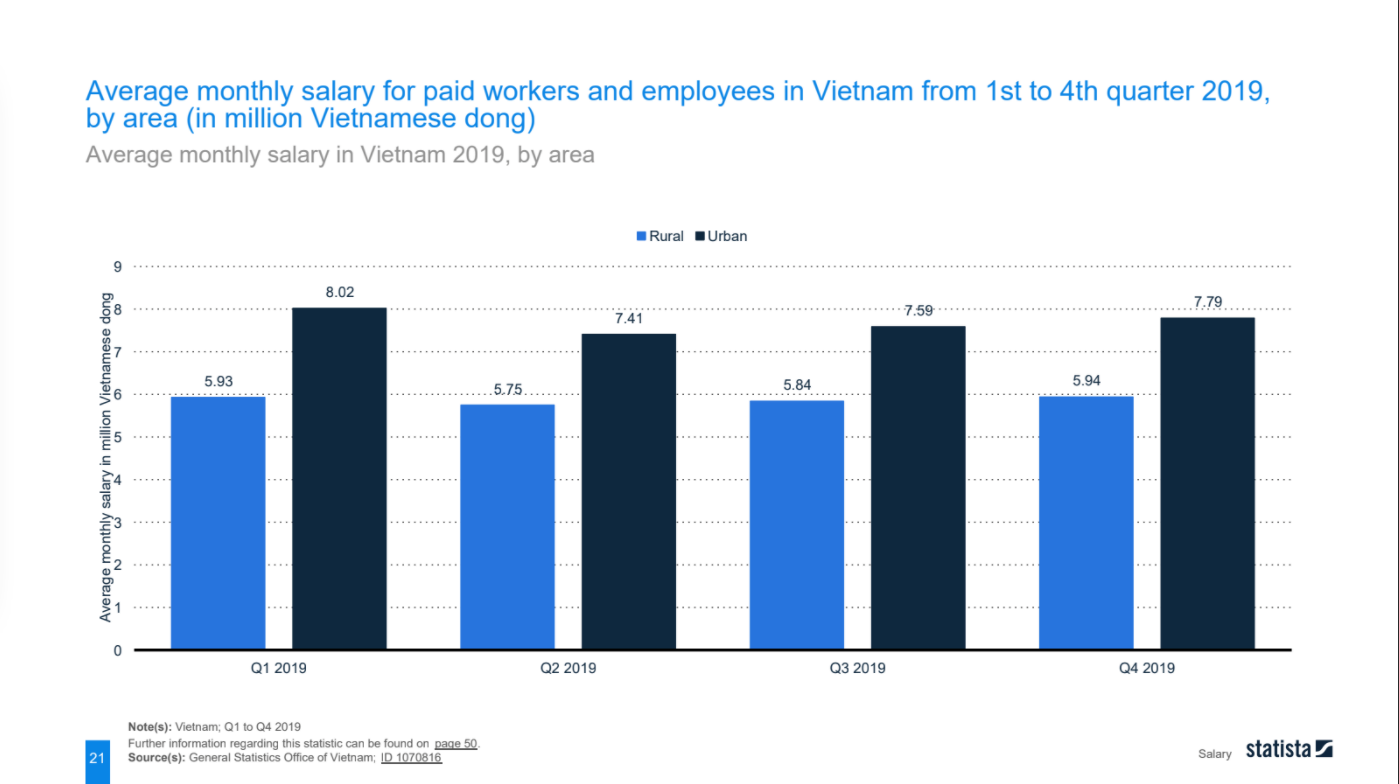
The average monthly salary in Vietnam 2019 shows that income is 0.424 to 0.436; in which the urban area tends to decrease, the rural area tends to increase and is always higher than in urban areas.
The average monthly salary in Vietnam in the 4th quarter of 2019 in urban areas reached 7.79 million VND, nearly 1.3 times higher than in rural areas (5.94 million VND), increased compared to the previous quarter but decreased 0.23 million VND compared to the 1st quarter. The same with average monthly salary in the rural area, which showed a slight increase from the 2nd quarter to 4th quarter, but decreased compared to the 1st quarter of 2019.
In 2019, the average monthly salary for paid workers and employees in Vietnam with no qualification was 5.78 million Dong, while the average monthly salary for those who had professional secondary school was around 7.02 million VND. And the average monthly salary for paid workers and employees with university and higher education was 9.23 million VND.

In the 4th quarter of 2019, the average monthly salary for paid workers and employees in the foreign investment sector was highest and reached about 8.66 million VND, while the average monthly salary was lowest in the Collective and Individual sectors. Besides, with the labor participation rate at 76.6 percent in Vietnam in 2019, the average monthly salary for paid workers and employees in Vietnam showed the highest in the Services industry (about 7.28 million VND in the 4th quarter of 2019). The average monthly salary was the lowest, around 4.4 million VND in the Agriculture, forestry, and fishery industries.
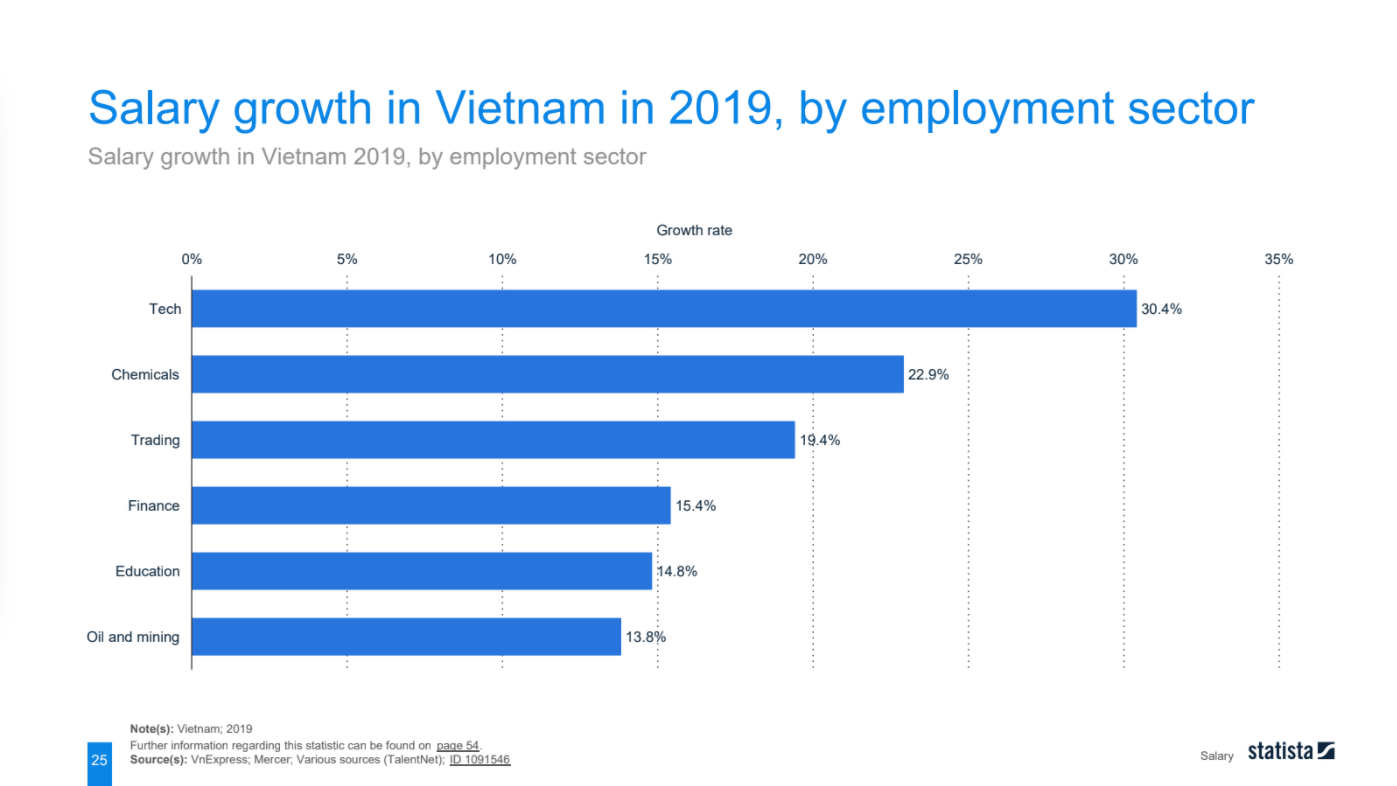
In Vietnam, The technology sector showed the highest salary growth overall in 2019. The tech salary growth rate in 2019 was 30.4%. The following industry with strong salary growth is Chemicals, with a growth rate of 22.9%, and Trading, with 19.4%. Also, in 2019, the non-banking financial industry in Vietnam had the highest growth of salary bonuses, with 30.4%. The lowest one is Logistics with a growth of salary bonus at 13.8%.
The unemployment rate in Vietnam tends to fluctuate around 2%. In 2020, the unemployment rate in Vietnam was 2.02%, a decrease of 0.31% compared to 1999 (2.33%). In the same year, the unemployment rate for individuals aged 15 to 24 years in Vietnam tended to increase from 2011 to 2020 and reached the highest rate at 7.6% in 2020; this rate was at 3.4% in 2011. In 2020, the youth unemployment rate (ages 15-24) was about 1.3 times higher than the average unemployment rate (5.81% for a decade). It can say that the pandemic of COVID19 has affected the youth workers of the whole country.
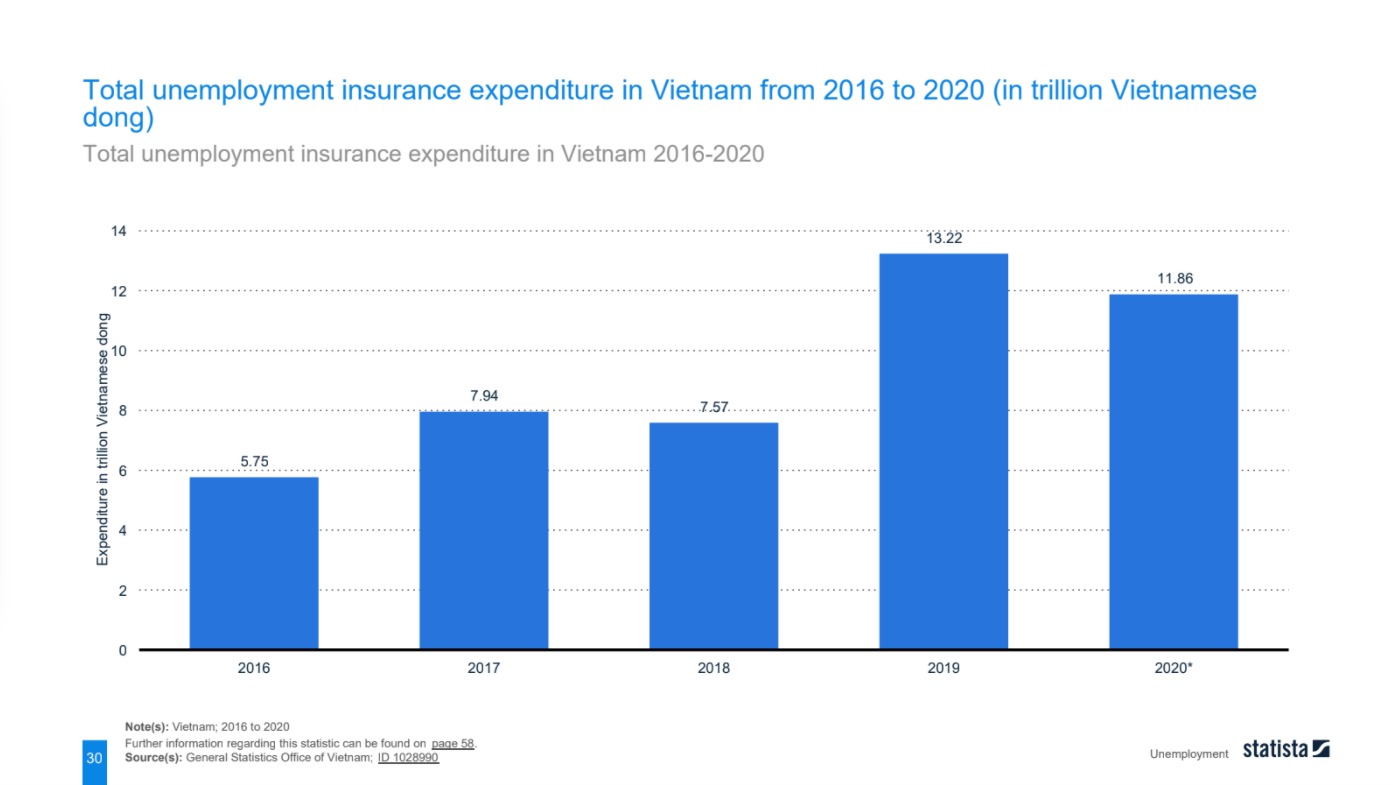
From 2016 to 2020, Vietnam's total unemployment insurance expenditure reached the highest amount, amounting to about 13.22 trillion VND. The unemployment insurance expenditure decreased to 11.86 trillion VND in 2020.
The unemployment insurance revenue in Vietnam will increase from 2016 to 2019 and decrease in 2020. The unemployment insurance revenue amounted to approximately 20 trillion VND, lower than in 2019 (22.14 trillion VND).
The COVID-19 epidemic pushed 1.3 million people in Vietnam into unemployment in 2020, most of them of working age. Particularly in the fourth quarter of 2020, there were about 1.2 million unemployed people, an increase of 136,800 people compared to the same period last year. Besides, the labor income in the service sector decreased the most, followed by the agriculture, forestry, and fishery industries, the industry, and construction labor income was the lowest decrease. To have a comprehensive look at Employment in Vietnam, you can download the full report here.